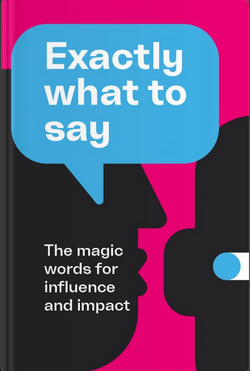Mar 25, 2025
Book Summary (Exact;y What to Say)

Have you ever been in a situation where you don't know what to say? Maybe you blushed and smiled your way out after facing rejection. Or someone doesn't take your pitch seriously, and you begin latching onto some cliches to save yourself.
\
It likely felt awkward, and you probably don't want to be in such a position again.
If you're a salesperson or your professional life involves communication, you might use some negotiation training. Luckily, that's what this summary holds for you!
Further, you'll find prompts to enhance your sales and communication skills, helping you reach your goals and expand your client web. Imagine confidently closing deals, getting promoted, or finding a win-win settlement with a coworker!
Even though you should strive to keep a conversation as natural as possible, these phrasing ideas will help you maintain control in negotiation.
I don't know if it's for you, but...
When promoting something, there is a thin line between being enthusiastic and appearing pushy. That's where the wording is essential.
If you open up with, "I don't know if it's for you, but... this idea excites me," the audience will feel that there's no pressure. You're not telling them what to want or to think but simply sharing your impressions. Using this approach, you will ignite people's interest instead of swaying them.
Being open-minded is associated with creativity, progress, and, ultimately, success. That's why if you ask people if they perceive themselves as open-minded, nine out of ten will probably say "yes."
So, for instance, instead of asking, "Would you like to try our CRM system?" you can reword your introduction to "How open-minded are you about trying our CRM system?" That way, your listeners will perceive your product as innovative and valuable.
What do you know about...
When trying to get an idea across, you might face a wall of preconceived notions. People assume they know what you're talking about and might show you they don't need your help. Yet, there is a clever way to regain control over such a situation!
Asking them about their expertise in your area will emphasize that you know best. You can ask, "What do you know about how we do things in our company?" Then, picking up from there, you can confidently explain how your product or service differs.
Behind every human action stands motivation — a certain story that drives people to seek or avoid something.
To influence someone to buy a gym membership, you should first give them a motive. The best way to do that is to kindle a joyful yet realistic vision in them: "What would it feel like if you were in your best shape a year from now?"
Making every conversation count
Moving people toward a decision usually takes more than one conversation. Yet, these phrases will help you make every interaction profitable. Just imagine...
Did you know that you make every decision at least twice? First, you play out a scenario in your imagination and then implement it into reality. So, before taking action, you see yourself doing it. And people around you are pretty much the same.
If you're trying to sell a trip to a couple, appeal to their fantasy by saying, "Just imagine laying on the beach and not doing chores for two weeks. Wouldn't that be refreshing?"
When would be the best time?
Many ideas fail because someone in charge didn't have the time to consider them properly.
Imagine someone promising to give you feedback on a presentation and not circling back on the matter. Instead of letting your offer die, you can reach out to them, saying, "I'm assuming you haven't got around to looking through my presentation yet."
I'm assuming you haven't got around to...
Imagine someone promising to give you feedback on a presentation and not circling back on the matter. Instead of letting your offer die, you can reach out to them, saying, "I'm assuming you haven't got around to looking through my presentation yet."
Most people don't feel comfortable breaking promises, so such phrasing will likely prompt them to find a solution. They will likely answer, "I did, and here's what I think." That gives your offer a second life!
Any questions for me?
Instead of asking, "Do you have any questions?" at the end of a presentation, change it to "What questions do you have for me?"
Your listeners may ask you practical questions or say they have no additional queries. In that case, you can ask them about their decision right away.
Three options...
Offering people solutions spares them the thinking effort and allows you to highlight your preferred option.
It's a simple structure: "As I see it, you've got three options: hiring a housecleaner, vacuuming your apartment yourself, or buying a robot vacuum. What would be the easiest for you?"
By undefined
4 notes ・ 3 views
English
Intermediate